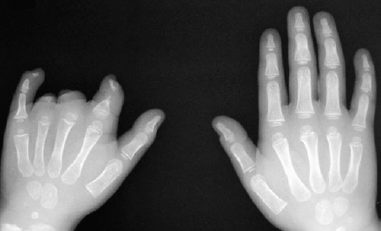79
Hypoplastic Digits and Hands
Scott H. Kozin
History and Clinical Presentation
A 4-year-old boy presented with a congenital anomaly of his left hand (Fig. 79–1). He is the product of a full-term pregnancy, born via cesarean section. There were no problems during pregnancy or delivery. The child is right hand dominant, but he is able to grasp cups and utensils with his left hand. He is otherwise healthy and has attained his developmental milestones (e.g., sitting, walking, and talking) at the normal time. Past medical history is positive for a heart murmur at birth that has resolved over time.
Physical Examination
The patient is a healthy-appearing and attentive child with full motion of his left shoulder, elbow, forearm, and wrist. The left thumb is normal in size and motion when compared with the right. The index, long, ring, and small digits are diminished in size (Fig. 79–1). The index finger has a remnant of proximal phalanx present and a small nail. The long and ring fingers have no bony support distal to the metacarpal. There are skin tubes distal to the metacarpal with small nails present. The small digit is larger than the other fingers with full metacarpophalangeal joint motion, but no active or passive motion of the proximal interphalangeal joint. The distal phalanx is inclined in a radial direction and the distal interphalangeal joint motion is 0 to 40 degrees. The right upper extremity and legs are normal. No chest wall abnormalities were noted. No amniotic bands were present on any of the extremities.

Figure 79–1 (A) Dorsal view of a 4-year-old child with small index, long, and ring digits and rudimentary nails. (B) Palmar view of shortened digits and radial deviation of the small finger.

PEARLS
- Children with hypoplastic digits are often capable of remarkable function.
- A thumb and digit with adequate length and mobility can provide sufficient pinch and grasp.
- Nonvascularized toe transfer is best indicated in aphalangia.
PITFALLS
- Digital lengthening is difficult and requires frequent monitoring to avoid potential complications.
- On-top plasty requires extensive neurovascular dissection to prevent vascular compromise of digit.
- Toe-to-hand transfer in the congenially anomalous hand is difficult.
Diagnostic Studies
Radiographs of both hands revealed several abnormalities of the left hand (Fig. 79–2). The thumb appeared normal in size and bony configuration. The fingers had normal metacarpals with considerable deficiencies at the phalangeal level. The index digit had a metacarpophalangeal joint with a remnant of proximal phalanx. The long and ring fingers had no phalanges. The small digit had normal-appearing joints and radial deviation of the distal interphalangeal joint.
Differential Diagnosis
Constriction band syndrome
Hypoplastic digits
Brachydactyly
Poland’s syndrome
Stay updated, free articles. Join our Telegram channel

Full access? Get Clinical Tree








